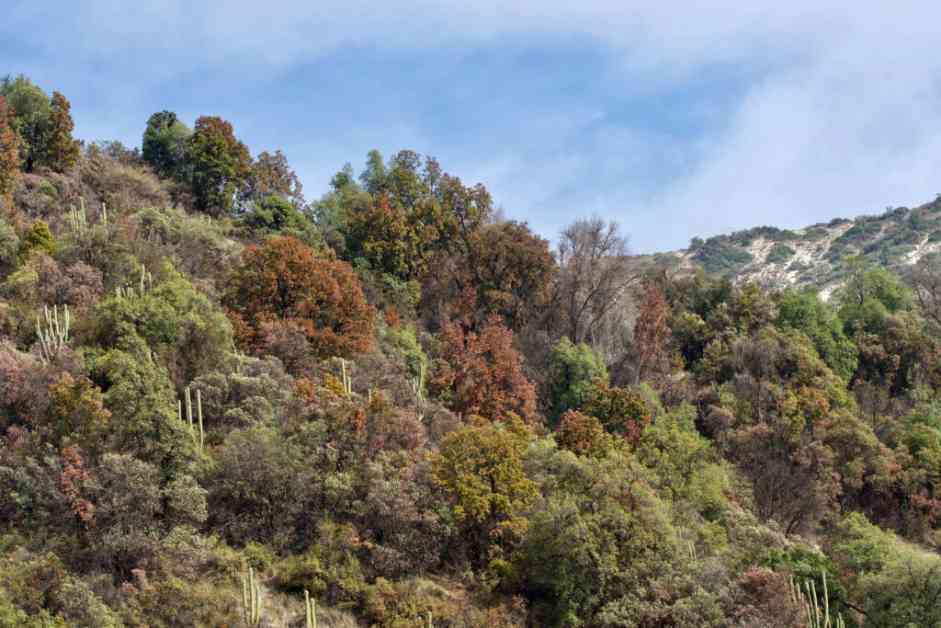Chile’s Declining Forest: The Impact of Drought and Urban Expansion
As a 10-year-old, Alberto Alaniz embarked on a school field trip to Río Clarillo National Park, a lush forest reserve near Chile’s bustling capital. The memories of that day are etched in his mind—the dense trees, the cool air, the sense of wonder. Fast forward more than two decades, and Alaniz returned to Río Clarillo only to be met with a stark and distressing reality.
“There wasn’t a forest anymore,” he recalled with a heavy heart. “There was a scrub.”
In the past 15 years, Chile has grappled with a crippling drought that has left its mark on the country’s sclerophyllous forests. These unique ecosystems, characterized by their hardy, evergreen vegetation, have borne the brunt of higher temperatures and lower rainfall, leading to unprecedented levels of stress on the trees.
The Changing Landscape: Challenges and Consequences
In recent years, the once-green tree canopies have turned brown, losing their vitality and ability to absorb carbon dioxide from the atmosphere. Coupled with deforestation driven by urban expansion and the introduction of non-native tree species, the forests have been fragmented into smaller, disconnected patches, exacerbating the environmental crisis.
The repercussions of these environmental shifts are multifaceted, impacting not only the natural world but also the economic and cultural fabric of Chile. Endemic species teeter on the brink of extinction, pollination rates have plummeted, spelling trouble for local beekeepers, and rural communities live in fear of escalating temperatures and the specter of more frequent wildfires.
The Personal Toll: A Scientist’s Perspective
For Alberto Alaniz, now a postdoctoral fellow at the University of Santiago, Chile, the decline of Chile’s forests hits close to home. A member of the university’s Laboratory of Biodiversity and the Environment, Alaniz has been studying the effects of anthropogenic climate change on ecosystems across the country. His firsthand experience of witnessing the transformation of the forests he once knew as a child underscores the personal impact of environmental degradation.
In a bid to shed light on the severity of the situation, Alaniz led a groundbreaking study published in the journal Science of the Total Environment. The study, conducted in collaboration with a team of researchers, offers a comprehensive risk analysis of individual sclerophyllous forest stands in central and coastal Chile, shedding light on the imminent threats facing these ecosystems.
Unveiling the Findings: A Wake-Up Call for Conservation
The study’s findings paint a grim picture, revealing that nearly 40 percent of forest stands are at high or very high risk of collapse, a term used by ecologists to describe the severe disruption and transformation of ecosystems. Moreover, over 90 percent of stands exhibit signs of decreased physical health and resilience, pointing to a looming crisis that demands urgent attention.
Juan Ovalle, an assistant professor at the University of Chile’s Faculty of Forest Sciences and Nature Conservation, emphasizes the urgency of the situation. While not directly involved in the study, Ovalle echoes the concerns raised by Alaniz and his team, stressing the need for immediate conservation measures to safeguard the endangered ecosystems.
Looking Ahead: Conservation Strategies and Hope for the Future
As the fate of Chile’s forests hangs in the balance, Alaniz and his colleagues advocate for targeted conservation efforts, emphasizing the importance of restricting land-use changes in high-risk forest units and allocating resources for restoration. Ovalle, on the other hand, calls for heightened legal protections for endangered endemic species, offering a lifeline to the fragile ecosystems.
While recent years have seen a temporary resurgence in the greenery of Chile’s forests, experts caution that the underlying threats persist. The looming specter of drought, wildfires, and habitat loss continues to cast a shadow over the future of these vital ecosystems. The resilience of the sclerophyllous forest hangs in the balance, teetering between adaptation and collapse.
For scientists like Alberto Alaniz, the stakes are higher than ever. The imperative to preserve these ecosystems is not just a scientific endeavor but a deeply personal mission rooted in childhood memories and a deep-seated connection to the natural world. As he reflects on the need to protect these irreplaceable landscapes for future generations, Alaniz’s words resonate with a sense of urgency and hope.
As Chile grapples with the challenges of a changing climate and shrinking forests, the call to action grows louder. The fate of these ecosystems rests in the hands of policymakers, conservationists, and communities united in their commitment to safeguarding Chile’s natural heritage. Only time will tell whether these efforts will be enough to ensure a sustainable future for the country’s iconic forests.














